Paleontology

A new hypothesis aims to explain how the complex vertebrate body, with its skeleton, muscles, nervous and cardiovascular systems, arises from a single cell during development and how these systems evolved over time. They give it a proper name, embryo geometry, but scientists are going to hold off on calling it a theory until it shows some chance of validation. Until then, it is like String Theory, more philosophy than science.
The paper, along with illustrations - or "blueprints" - depicting how it applies to different vertebrate organ systems, is in Progress in Biophysics&Molecular…
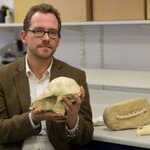
A new paper in the Journal of Evolutionary Biology reviewed all mammal species known from the end of the Cretaceous period in North America and found that over 93 percent became extinct across the Cretaceous-Paleogene (K-Pg) boundary, due to the same asteroid that killed the dinosaurs in the Cretaceous period 66 million years ago.
That's significantly more than previously thought - but mammals also recovered far more quickly than previously though.
The published fossil record from western North America from two million years before the Cretaceous-Paleogene boundary until 300,000 years…
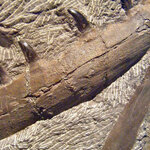
A close-up of the dentition of an ancient marine, carnivorous lizard, the mighty Mosasaur, from Late Cretaceous exposures on Vancouver Island. Mosasaurs were air breathers and powerful swimmers.
They gave birth to live young, similar to sea turtles, seeking out the safety of a sandy shore to lay their eggs. This well-prepped specimen is housed in the collections of the Courtenay Museum, Vancouver Island, British Columbia.
The creature who belonged to this jaw bone undoubtedly swan alongside Kourisodon puntledgensis, another enormously powerful marine predator and new species of…
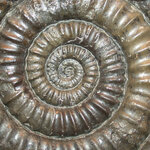
A great temple to the god Amon was built at Karnak in Upper Egypt around c. 1785. It is from Amon that we get his cephalopod namesake. Pliny the Elder, who lived around 79 AD near Pompeii, called these fossils ammonis cornua or "horns of Ammon" because they reminded him of the Egyptian god of sun and air, Ammon (Amun). Amun was often depicted wearing ram's horns.We have these coiled cephalopods to thank for the naming of the compound ammonia, NH3, the simplest pnictogen hydride, a colorless gas with a distinctive pungent smell. Ammonites were a group of hugely successful aquatic molluscs that…
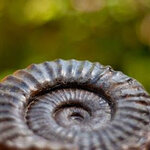
This Jurassic ammonite is from an all but inaccessible site in Sayward, Bonanza Group, Vancouver Island.
By the time these ammonites were being buried in sediment, Wrangellia, the predominately volcanic terrane that now forms Vancouver Island and the Queen Charlotte Islands, had made its way to the northern mid-latitudes.
Within the basal part of the sequence, sedimentary beds are found interbedded with lapilli and crystal-tuffs. They include maroon tuffaceous sandstone, orange-grey sandstone, granule sandstone and conglomerate. Ammonites are found alongside gastropods and pelecypods. The…
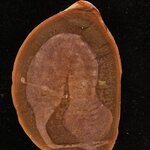
Today in Science Codex I read this article
Monster mystery solved
The Monster is a strange fossil, found only in the Mazon Creek fossil beds, roughly 30 miles south-west of Chicago. It was found in 1958 by an amateur fossil collector named Francis Tully, and so perplexed palaeontologists that it acquired the name “The Tully Monster”, incorporated into its scientific name Tullimonstrum gregarium. The sediments at Mazon Creek date to 307 million years ago (Upper Carboniferous aka Pennsylvanian) and the peculiar conditions of fossilization allowed this remarkable preservation.
The…

Long before the dinosaurs, hefty herbivores called pareiasaurs ruled the Earth. A detailed investigation of all Chinese specimens of these creatures - often described as the 'ugliest fossil reptiles' - has been published in the Zoological Journal of the Linnean Society.
Pareiasaurs have been reported from South Africa, Europe (Russia, Scotland, Germany), Asia (China), and South America, but it is not known whether there were distinct groups on each of these continents.
In a new study, Professor Mike Benton of University Bristol shows there are close similarities between Chinese fossils…
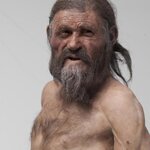
Scientists are continually unearthing new facts about Homo sapiens from the mummified remains of Ötzi, the Copper Age man, who was discovered in a glacier in 1991.
Five years ago, after Ötzi's genome was completely deciphered, it seemed that the wellspring of spectacular discoveries about the past would soon dry up.
An international team of scientists have now succeeded in demonstrating the presence of Helicobacter pylori in Ötzi's stomach contents, a bacterium found in half of all humans today. The theory that humans were already infected with this stomach bacterium at the very beginning…

The discovery of exceptionally well-preserved, tiny fossil seeds dating back to the Early Cretaceous corroborates that flowering plants were small opportunistic colonizers at that time, according to a new study.
Angiosperms, or flowering plants, diversified during the Early Cretaceous, about 100 to 130 million years ago. Based on evidence from living and fossil plants, the earliest angiosperms are usually thought to have had small stature. New data from the fossil record presented here strongly support this notion, but also indicates key differences from modern flowering plants.
The small…

A "dinosaur" fossil originally discovered on Prince Edward Island has been shown to have steak knife-like teeth, and researchers from U of T Mississauga, Carleton University and the Royal Ontario Museum have changed its name to Dimetrodon borealis, marking the first occurrence of a Dimetrodon fossil in Canada.
Fossils of Dimetrodon have now been found in the USA, Canada and Germany.
The fossil, previously known at Bathygnathus borealis, was collected in 1845 while a farmer was digging out a well on his property near French River, PEI. As there were no natural history…